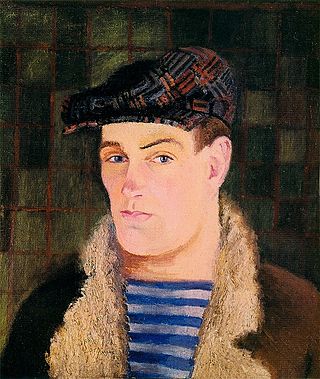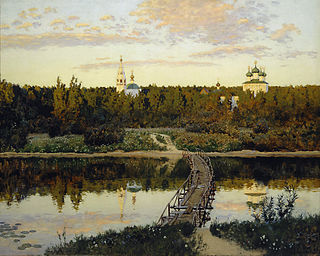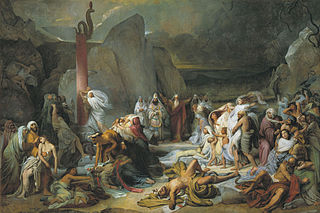
The Tale of Woe, the Letter of Wermai or Papyrus Moscow 127, is an Egyptian document from the late 20th Dynasty to 22nd Dynasty, part of a collection of three papyri including the Onomasticon of Amenope and the Story of Wenamun.

Sergey Ivanovich Markin — Moscow professional artist, painter and artist-decorator of the TRAM Theater. Master of urban landscape and narrative compositions conveying the spirit of the pre-war era. He was a member of the Pleiades of Artists of the 1920s-1930s. He worked in the Moscow Union of Artists (MOSSH). He died in battles near Moscow in the first year of the Great Patriotic War.

The State Museum of Modern Western Art was a museum in Moscow. It originated in the merger of the 1st and 2nd Museums of Modern Western Painting in 1923. It was based on the collection of paintings assembled by Sergei Schukin and Ivan Morozov. It was shut down on 6 March 1948 by Stalin and its works split between the Hermitage Museum in St. Petersburg and the Pushkin Museum in Moscow.

Aurora and Cephalus is an 1811 painting by Pierre-Narcisse Guérin, now in the Pushkin Museum in Moscow. Measuring 251 × 178 cm, it illustrates lines 661-866 of Book 7 of Ovid's Metamorphoses and is a version the artist's 1810 work of the same subject. An oil sketch for the 1811 work has been in the Hermitage Museum since 1978.

Vairumati tei Oa is an 1892 painting by Paul Gauguin, produced during his time in Polynesia. Its title translates as Her name was Vairaumati. It remained in the artist's family before passing to Ambroise Vollard's gallery in Paris. Sergei Schukin acquired it from the latter in 1904 and in 1918 it was acquired by the 1st Museum of New Western Painting. Since 1948 it has been in the Pushkin Museum in Moscow.

Self-Portrait on an Easel is a 1603-1604 oil on panel painting by Annibale Carracci, now displayed in Room 231 of the New Hermitage Building of the Hermitage Museum in Saint Petersburg. The portrait from the work was repeated for an autograph self-portrait now in the Uffizi, whilst a 1595 version of the Hermitage work is also in the Uffizi.

Ploughed Fields is an 1874 painting by Camille Pissarro, now in the Pushkin Museum in Moscow.

Landscape with Hercules and Cacus is an oil on canvas painting by French painter Nicolas Poussin, created c. 1660. It is held in the Pushkin Museum, in Moscow. It depicts a scene from lines 190-275 of Book VIII of Virgil's Aeneid.

Piazza della Rotonda and the Pantheon is an oil-on-canvas cityscape painting by the Italian painter Bernardo Bellotto and his son Lorenzo, from 1769, based on an engraving by Piranesi. It and its pair View of the Forum in Rome are both now in the Pushkin Museum, in Moscow. It shows Piazza della Rotonda and the Pantheon, in Rome.

Pierrot and Harlequin or Mardi Gras is an 1888-1890 oil on canvas painting by Paul Cézanne, now in the Pushkin Museum in Moscow. As the title suggests, it shows the commedia dell'arte characters Pierrot and Harlequin.

The Rape of Europa is an oil on canvas painting by Claude Lorrain, from 1655. With its pendant The Battle of the Milvian Bridge, it is now in the Pushkin Museum, in Moscow.

A Quiet Monastery is a landscape by Russian artist Isaak Levitan (1860–1900), painted in 1890. It belongs to the State Tretyakov Gallery in Moscow. Its size is 87.5×108 cm.

The Brazen Serpent is a giant painting by the Russian artist of Italian origin Fyodor Bruni (1799-1875), completed in 1841. It is part of the collection of the State Russian Museum in St. Petersburg. The size of the painting is 565×852 cm.

A Birch Grove is a landscape by the Russian artist Arkhip Kuindzhi (1842–1910), completed in 1879. It is kept in the State Tretyakov Gallery. The size of the painting is 97×181 cm. The canvas depicts birch trees growing in a sunny forest clearing. The unusual combinations of light and color and sharp contrast of sun and shadow create the impression of very bright sunlight. The upper part of the birches is not shown; only the trunks and small branches are visible, which stand out in light green against the background of the dark green forest. The composition is divided into two parts by a stream running through the middle.

All in the Past is a painting by Russian artist Vassily Maximov (1844-1911), completed in 1889. It belongs to the State Tretyakov Gallery. The size of the canvas is 72×93.5 cm. The painting depicts two elderly women: a lady and her maid, sitting on the wing's threshold of an outhouse on a sunny spring day. In the background, the main building of the estate is in a neglected state, with boarded up windows.

Taking a Snow Town is a painting by the Russian artist Vasily Surikov (1848–1916), completed in 1891. It is kept in the State Russian Museum in St. Petersburg. The size of the canvas is 156×282 cm. The painting depicts the climax of an ancient folk game popular among the Siberian Cossack community. According to tradition, the game was organized on the last day of Maslenitsa, and the artist, who grew up in Krasnoyarsk, observed it many times during his childhood. Surikov worked on the canvas during his stay in Krasnoyarsk from 1889 to 1890, and finished it after his return to Moscow. Many of his relatives and acquaintances served as sitters.

By the Pool is a landscape by the Russian artist Isaac Levitan (1860–1900), completed in 1892. It is kept in the State Tretyakov Gallery in Moscow. The size is 150×209 cm. The foreground of the canvas shows small bridges leading into the timbers of a dam, with a pond to the right. On the other side of the river, a narrow path leads past coastal bushes into a dark twilight forest.

Newspaper Readers in Naples is a painting by the Russian artist Orest Kiprensky (1782–1836), painted in 1831. It belongs to the State Tretyakov Gallery. The size of the painting is 64.5 × 78.3 cm. It is titled Readers of Newspaper, Newspaper Readers in Italy, Reading a Newspaper, Travelers Reading the Gazette de France and others. The painting is a group portrait of four men, one reading a newspaper and the others listening. The nationality of the figures in the painting has been interpreted differently by various researchers of Kiprensky's work: they have been called either Russian or Polish.

Harvest Time (Mowers) (Russian: Страдная пора (Косцы)) is a painting by Russian artist Grigoriy Myasoedov (1834–1911), completed in 1887. It is kept in the State Russian Museum in St. Petersburg (Inventory Zh-6899). The size is 164 × 282 cm (according to other data, 179 × 275 cm). The work, combining elements of domestic genre and landscape, is devoted to the theme of peasant labor during the harvest. The painting was originally known under the title Harvest Time; later, the names Harvest and Croppers were also used. Modern literature usually uses the double title, Harvest Time (Mowers) or Harvest Time. Mowers.

Welcoming the Icon is a painting by Russian artist Konstantin Savitsky (1844–1905), which was completed in 1878. It is stored in the State Tretyakov Gallery in Moscow. The size of the painting is 141 × 228 cm. This painting is a multi-figure genre canvas that represents an episode of peasant life and was painted during the Russo-Turkish War of 1877–1878. Savitsky worked on it in Daugavpils.




















